Citroen C-Elysee (2017 year). Instruction — part 11

159
9
Practical information
C-elysee_en_Chap09_info-pratiques_ed01-2016
Changing a fuse
The extraction tweezer is fitted to the back of
the dashboard fusebox cover.
F
unclip the cover by pulling at the top right,
then left,
F
disengage the cover completely and turn it
over,
Access to the tools
F
remove the tweezer.
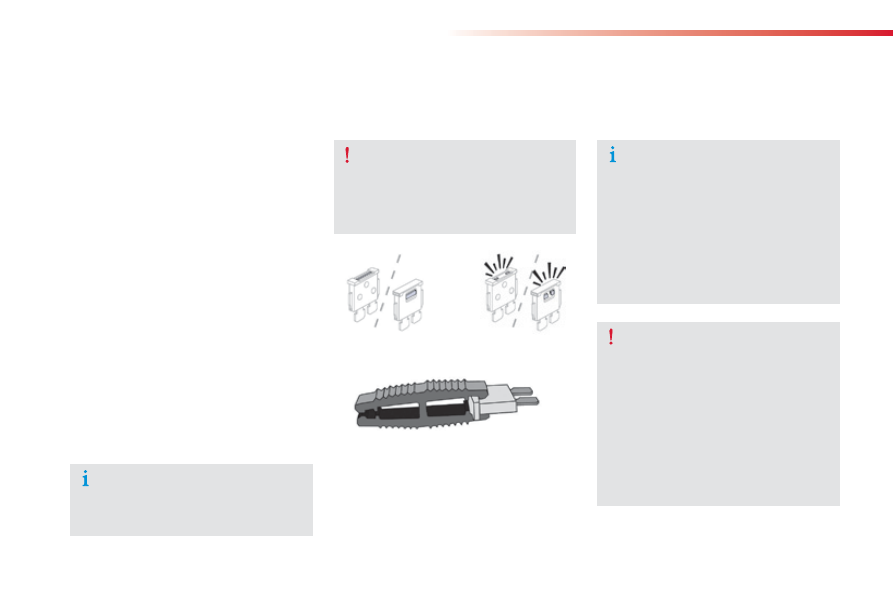
160
Practical information
C-elysee_en_Chap09_info-pratiques_ed01-2016
Changing a fuse
Good
Failed
CITROËN will not accept responsibility
for the cost incurred in repairing your
vehicle or for rectifying malfunctions
resulting from the installation of
accessories not supplied and not
recommended by CITROËN and
not installed in accordance with its
instructions, in particular when the
combined consumption of all of the
additional equipment connected
exceeds 10 milliamperes.
Installing electrical
accessories
Your vehicle's electrical system is
designed to operate with standard or
optional equipment.
Before installing other electrical
equipment or accessories on your
vehicle, contact a CITROËN dealer or a
qualified workshop.
Before changing a fuse:
F
the cause of the failure must be identified
and rectified,
F
all electrical consumers must be switched
off,
F
the vehicle must be immobilised with the
ignition off,
F
identify the failed fuse using the tables and
layout drawings in the following pages.
To replace a fuse, you must:
F
use the special tweezer to extract the fuse
from its housing and check the condition of
its filament.
F
always replace the failed fuse with a fuse
of the same rating (same colour); using
a different rating could cause faults (risk
of fire).
Tweezer
The replacement of a fuse not shown in
the tables below may cause a serious
malfunction of your vehicle. Contact
a CITROËN dealer or a qualified
workshop.
If the fuse fails again soon after
replacement, have the vehicle's electrical
system checked by a CITROËN dealer or
a qualified workshop.
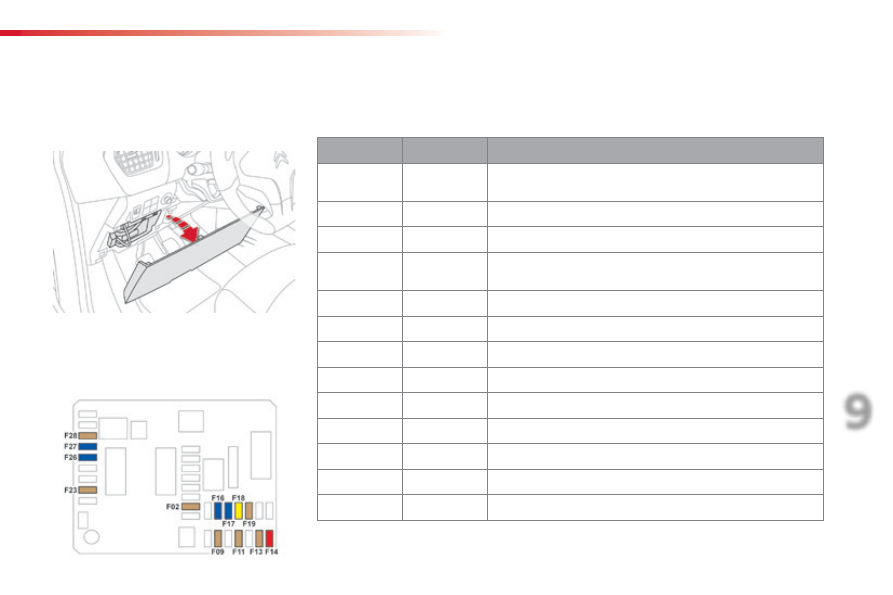
161
9
Practical information
C-elysee_en_Chap09_info-pratiques_ed01-2016
Dashboard fuses
The fusebox is placed in the lower dashboard
(left-hand side).
Access to the fuses
F
Refer to the paragraph "Access to the tools".
Fuse N°
Rating
Functions
F02
5 A
Headlamp adjusters, diagnostic socket, air conditioning
panel.
F09
5 A
Alarm, alarm (accessory).
F11
5 A
Additional heating.
F13
5 A
Parking sensors, parking sensors
(accessory)
F14
10 A
Air conditioning panel.
F16
15 A
Cigarette lighter, 12 V socket.
F17
15 A
Audio system, audio system (accessory).
F18
20 A
Audio system / Bluetooth, audio system (accessory).
F19
5 A
Monochrome screen C.
F23
5 A
Courtesy lamps, map reading lamps.
F26
15 A
Horn.
F27
15 A
Screenwash pump.
F28
5 A
Anti-theft.
Fuse tables

162
Practical information
C-elysee_en_Chap09_info-pratiques_ed01-2016
Fuse N°
Rating
Functions
F29
-
Not used.
F30
10 A
Heated door mirrors.
F31
25 A
Heated rear window.
F32
-
Not used.
F33
30 A
Front electric windows.
F34
30 A
Rear electric windows.
F35
30 A
Heated front seats.
F36
-
Not used.
F37
20 A
Trailer interface.

163
9
Practical information
C-elysee_en_Chap09_info-pratiques_ed01-2016
Fuse N°
Rating
Functions
F14
15 A
Heated lower windscreen.
F15
5 A
Air conditioning compressor.
F16
15 A
Front foglamps.
F18
10 A
Right hand main beam headlamp.
F19
10 A
Left hand main beam headlamp.
F29
40 A
Front wiper motor.
F30
80 A
Pre-heater plugs (Diesel).
Access to the fuses
F
Unclip the cover.
F
Change the fuse (see corresponding
paragraph).
F
When you have finished, close the cover
carefully to ensure correct sealing of the
fusebox.
Fuse table
Engine compartment
fuses
The fusebox is placed in the engine
compartment near the battery (left-hand side).
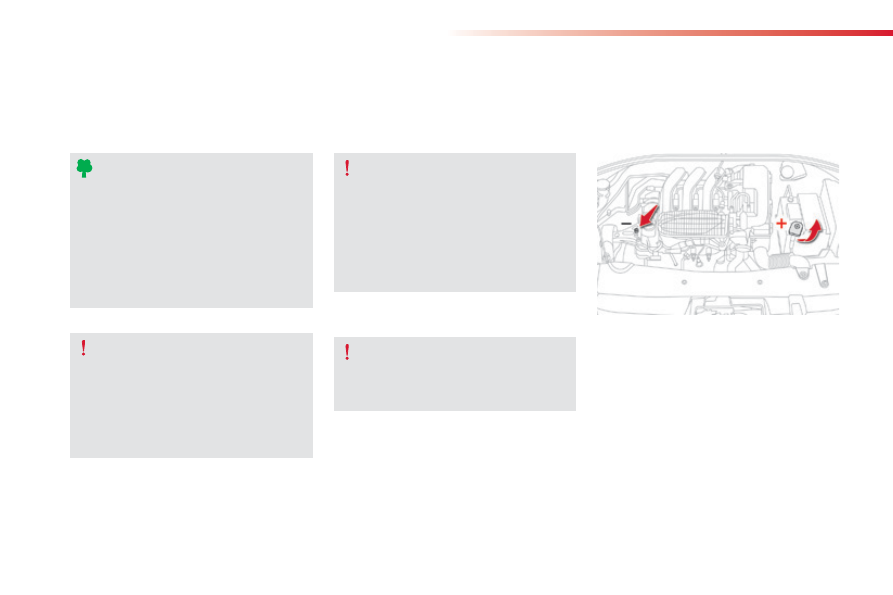
164
Practical information
C-elysee_en_Chap09_info-pratiques_ed01-2016
12 V battery
Procedure for starting the engine using another battery or charging a discharged battery.
The battery is located under the bonnet.
To gain access to it:
F
open the bonnet using the interior release
lever, then the exterior safety catch,
F secure the bonnet stay,
F
remove the plastic cover on the (+) terminal.
Access to the battery
General points
Lead-acid starter batteries
Protect your eyes and face before
handling the battery.
All operations on the battery must be
carried out in a well ventilated area and
away from naked flames and sources
of sparks, so as to avoid the risk of
explosion or fire.
Wash your hands afterwards.
Batteries contain harmful substances
such as sulphuric acid and lead.
They must be disposed of in
accordance with regulations and must
not, in any circumstances, be discarded
with household waste.
Take used remote control batteries and
vehicle batteries to a special collection
point.
Versions equipped with Stop & Start are
fitted with a 12 V lead-acid battery of
specific technology and specification.
Its replacement should be carried out
only by a CITROËN dealer or a qualified
workshop.
If you have an electronic or automatic
gearbox, never try to start the engine by
pushing the vehicle.
The (-) terminal of the battery is not accessible.
A remote earth point is located on the engine.

165
9
Practical information
C-elysee_en_Chap09_info-pratiques_ed01-2016
Starting using another
battery
F
Start the engine of the vehicle with the
good battery and leave it running for a
few minutes.
F
Operate the starter on the broken down
vehicle and let the engine run.
If the engine does not start straight away,
switch off the ignition and wait a few
moments before trying again.
Never try to start the engine by
connecting a battery charger.
Never use a 24 V or higher battery
booster.
First check that the slave battery has a
nominal voltage of 12 V and a capacity
at least equal to that of the discharged
battery.
The two vehicles must not be in contact
with each other.
Switch off the electrical consumers on
both vehicles (audio system, wipers,
lighting, ...).
Ensure that the jump lead cables do
not pass close to moving parts of the
engine (cooling fan, belts, ...).
Do not disconnect the (+) terminal when
the engine is running.
When your vehicle's battery is discharged, the
engine can be started using a slave battery
(external or on another vehicle) and jump lead
cables or a battery booster.
F
Raise the plastic cover on the (+) terminal,
if your vehicle has one.
F
Connect the red cable to the positive
terminal (+) of the flat battery A (at
the metal elbow) then to the positive
terminal (+) of the slave battery
B or the
booster.
F
Connect one end of the green or black
cable to the negative terminal (-) of the
slave battery
B or the booster (or earth
point on the other vehicle).
F
Connect the other end of the green or black
cable to the earth point
C on the broken
down vehicle.
F
Wait until the engine returns to idle then
disconnect the jump lead cables in the
reverse order.
F
Refit the plastic cover to the (+) terminal, if
your vehicle has one.
F
Allow the engine to run for at least
30 minutes, by driving or with the vehicle
stationary, so that the battery reaches an
adequate state of charge.
Some functions, including Stop & Start,
are not available if the battery is not
sufficiently charged.

166
Practical information
C-elysee_en_Chap09_info-pratiques_ed01-2016
Charging the battery using
a battery charger
For optimum service life of the battery, it is
essential to maintain an adequate state of
charge.
In some circumstances it may be necessary to
charge the battery:
- if you use your vehicle essentially for short
journeys,
- if the vehicle is to be taken off the road for
several weeks.
Contact a CITROËN dealer or a qualified
workshop.
Never try to charge a frozen battery.
If the battery has been frozen, have
it checked by a CITROËN dealer or a
qualified workshop, who will check that
the internal components have not been
damaged and the casing is not cracked,
which could cause a leak of toxic and
corrosive acid.
If you envisage charging your vehicle's
battery yourself, use only a charger
compatible with lead-acid batteries of a
nominal voltage of 12 V.
If this label is present, it is essential
to use only a 12 V charger, to avoid
causing irreversible damage to the
electrical components related to the
Stop & Start system.
Follow the instructions for use provided
by the manufacturer of the charger.
Never reverse polarities.
It is not necessary to disconnect the
battery.
F
Switch off the ignition.
F
Switch off all electrical consumers (audio
system, lighting, wipers, ...).
F
Switch off the charger
B before connecting
the cables to the battery, so as to avoid any
dangerous sparks.
F
Ensure that the charger cables are in good
condition.
F Raise the plastic cover, if your vehicle has
one, on the (+) terminal.
F
Connect the charger
B cables as follows:
- the positive (+) red cable
to the (+) terminal of the battery A,
- the negative (-) black cable to the earth
point
C on the vehicle.
F
At the end of the charging operation, switch
off the charger
B before disconnecting the
cables from the battery A.

167
9
Practical information
C-elysee_en_Chap09_info-pratiques_ed01-2016
Disconnecting the (+) terminal
F Raise the lever A fully to release the
clamp
B.
Reconnecting the (+) terminal
F
Position the open clamp
B of the cable on
the positive post (+) of the battery.
F
Press down on the clamp to position it
correctly on the battery post.
F
Lock the clamp by lowering the lever A.
Do not force the lever as locking will
not be possible if the clamp is not
positioned correctly; start the procedure
again.
Disconnecting the battery
In order to maintain an adequate state
of charge for starting the engine, it is
recommended that the battery be disconnected
if the vehicle is taken out of service for a long
period.
Wait 2 minutes after switching off the ignition
before disconnecting the battery:
F
close all openings (doors, boot, windows,
roof),
F
switch off all electrical consumers (audio
system, wipers, lighting, ...),
F
switch off the ignition and wait for
four minutes.
Having exposed the battery, it is only
necessary to disconnect the (+) terminal.
Following reconnection of the
battery
After reconnecting the battery, switch on the
ignition and wait 1 minute before starting to
allow initialisation of the electronic systems.
However, if minor problems persist following
this operation, contact a CITROËN dealer or a
qualified workshop.
Referring to the corresponding section, you
must yourself reinitialise or reset certain
systems, such as:
- the remote control,
- the date and time,
- the radio preset stations.
Quick release terminal
The Stop & Start system may not be
operational during the trip following the
first engine start.
In this case, the system will only be
available again after a continuous
period of immobilisation of the vehicle,
a period which depends on the ambient
temperature and the state of charge of
the battery (up to about 8 hours).
168
Practical information
C-elysee_en_Chap09_info-pratiques_ed01-2016
System which manages the duration of use of
certain functions to retain a sufficient level of
charge in the battery.
After the engine has stopped, you can
still use functions such as the audio and
telematics system, windscreen wipers, dipped
beam headlamps, courtesy lamps, etc. for
a maximum combined duration of about
thirty minutes.
Electrical energy economy mode
Switching to economy mode
Once this time has elapsed, a message
appears in the screen indicating that the
vehicle has switched to economy mode and the
active functions are put on standby.
If a telephone call is being made at this time,
it will be maintained for around 10 minutes with
the Bluetooth hands-free system of your audio
system.
Exiting economy mode
These functions are reactivated automatically
next time the vehicle is driven.
F
To restore these functions immediately,
start the engine and let it run for at least
five minutes.
A flat battery prevents the engine from
starting (refer to the corresponding
section).
Load reduction mode
System which manages the use of certain
functions according to the level of charge
remaining in the battery.
When the vehicle is being driven, the load
reduction function temporarily deactivates
certain functions, such as the air conditioning,
the heated rear screen...
The deactivated functions are reactivated
automatically as soon as conditions permit.
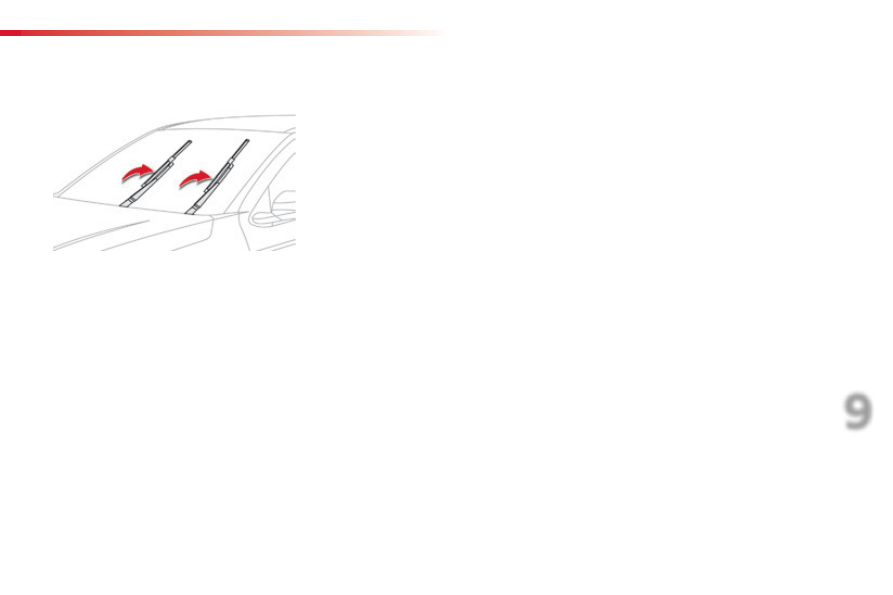
169
9
Practical information
C-elysee_en_Chap09_info-pratiques_ed01-2016
Changing a wiper blade
Before removing a front
wiper blade
F
Within one minute after switching off
the ignition, operate the wiper stalk to
position the wiper blades vertically on the
windscreen.
Removing
F
Raise the corresponding wiper arm.
F
Unclip the wiper blade and remove it.
Fitting
F
Put the corresponding new wiper blade in
place and clip it.
F
Fold down the wiper arm carefully.
After fitting a front wiper
blade
F
Switch on the ignition.
F
Operate the wiper stalk again to park the
wiper blades.

170
Practical information
C-elysee_en_Chap09_info-pratiques_ed01-2016
Towing the vehicle
Access to the tools
The towing eye is installed in the boot under
the floor.
To gain access to it:
F open the boot,
F
lift the floor and remove it,
F
remove the towing eye from the holder.
General recommendations
Observe the legislation in force in your country.
Ensure that the weight of the towing vehicle is higher than that of the towed vehicle.
The driver must remain at the wheel of the towed vehicle and must have a valid driving
licence.
When towing a vehicle with all four wheels on the ground, always use an approved towing
arm; rope and straps are prohibited.
The towing vehicle must move off gently.
When towing a vehicle with the engine off, there is no longer any power assistance for
braking or steering.
In the following cases, you must always call on a professional recovery service:
- vehicle broken down on a motorway or fast road,
- four-wheel drive vehicle,
- when it is not possible to put the gearbox into neutral, unlock the steering, or release
the parking brake,
- towing with only two wheels on the ground,
- where there is no approved towing arm available...
Procedure for having your vehicle towed.
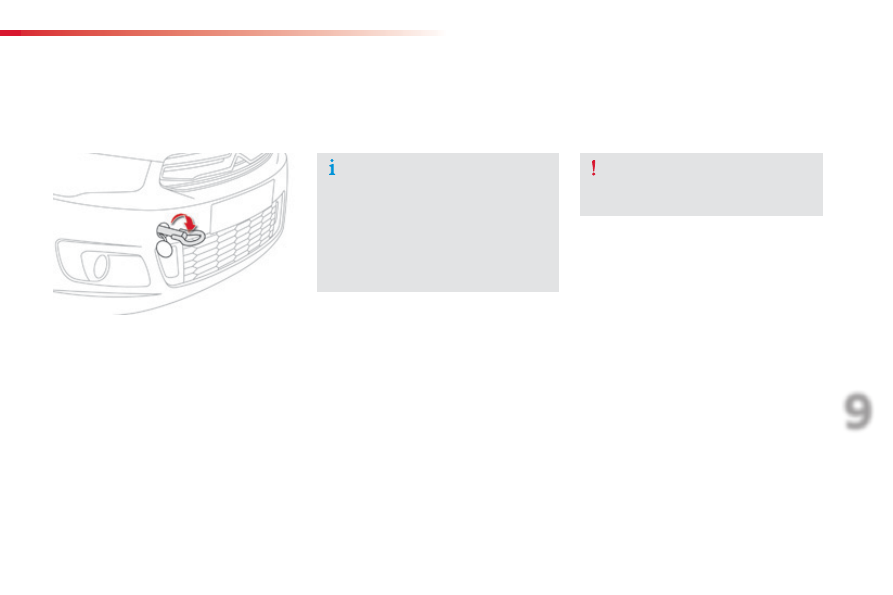
171
9
Practical information
C-elysee_en_Chap09_info-pratiques_ed01-2016
Towing your vehicle
Towing another vehicle
F
On the front bumper, unclip the cover by
pressing on the left edge.
F
Screw the towing eye in fully.
F
Install the towing bar.
Put the gear lever into neutral
(position N for an electronic or
automatic gearbox).
Failure to follow this instruction may
cause damage to some components
(braking, transmission...) and the
absence of braking assistance when
the engine is restarted.
F
Unlock the steering by turning the key
in the ignition one notch and release the
parking brake.
F
Switch on the hazard warning lamps on
both vehicles.
F
Move off gently, drive slowly and for a short
distance.
This towing is strictly prohibited (risk of
damaging your vehicle).
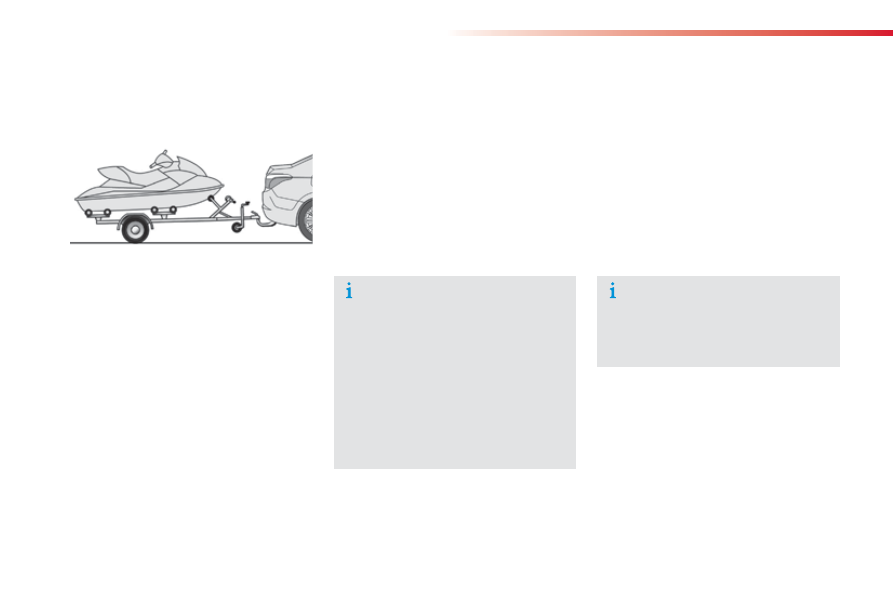
172
Practical information
C-elysee_en_Chap09_info-pratiques_ed01-2016
Towing a trailer
We recommend the use of genuine
CITROËN towbars and their harnesses
that have been tested and approved
from the design stage of your vehicle,
and that the fitting of the towbar is
entrusted to a CITROËN dealer or a
qualified workshop.
If the towbar is not fitted by a
CITROËN dealer, it must still be
fitted in accordance with the vehicle
manufacturer's instructions.
Your vehicle is primarily designed for
transporting people and luggage, but it may
also be used for towing a trailer.
Driving with a trailer places greater
demands on the towing vehicle and the
driver must take particular care.

173
9
Practical information
C-elysee_en_Chap09_info-pratiques_ed01-2016
Driving advice
Distribution of loads
F
Distribute the load in the trailer so that the
heaviest items are as close as possible to
the axle and the nose weight approaches
the maximum permitted without
exceeding it.
Air density decreases with altitude, thus
reducing engine performance. Above
1 000 metres, the maximum towed load must
be reduced by 10 % for every 1 000 metres of
altitude.
Side wind
F
Take into account the increased sensitivity
to side wind.
Cooling
Towing a trailer on a slope increases the
temperature of the coolant.
As the fan is electrically controlled, its cooling
capacity is not dependent on the engine speed.
F
To lower the engine speed, reduce your
speed.
The maximum towed load on a long incline
depends on the gradient and the ambient
temperature.
In all cases, keep a check on the coolant
temperature.
F
If the warning lamp and
the STOP
warning lamp come
on, stop the vehicle and switch
off the engine as soon as
possible.
Braking
Towing a trailer increases the braking distance.
To avoid overheating of the brakes on a long
mountain type of descent, the use of engine
braking is recommended.
Tyres
F
Check the tyre pressures of the towing
vehicle and of the trailer, observing the
recommended pressures.
Lighting
F
Check the electrical lighting and signalling
on the trailer.
Refer to the "Technical data" section for details
of the weights and towed loads which apply to
your vehicle.
The rear parking sensors will be
deactivated automatically if a genuine
CITROËN towbar is used.

174
Practical information
C-elysee_en_Chap09_info-pratiques_ed01-2016
Very cold climate screen(s)*
Removable protective screen(s) which prevents the accumulation of snow at the radiator cooling fan.
Depending on version, you have one or two screens.
Fitting
F
Offer up the corresponding screen to the
lower or upper section of the front bumper.
F
Press around its edge to engage its fixing
clips one by one.
Removal
F
Use a screwdriver as a lever to release
each of the fixings of each screen in turn.
* Depending on the country of sale.
Do not forget to remove the very cold
climate screen (or screens):
- when the ambient temperature
exceeds 10 °C,
- when towing,
- at speeds above 75 mph (120 km/h).

Нет комментариевНе стесняйтесь поделиться с нами вашим ценным мнением.
Текст